Tag Archives: 1980s
Opera and ballet theatre
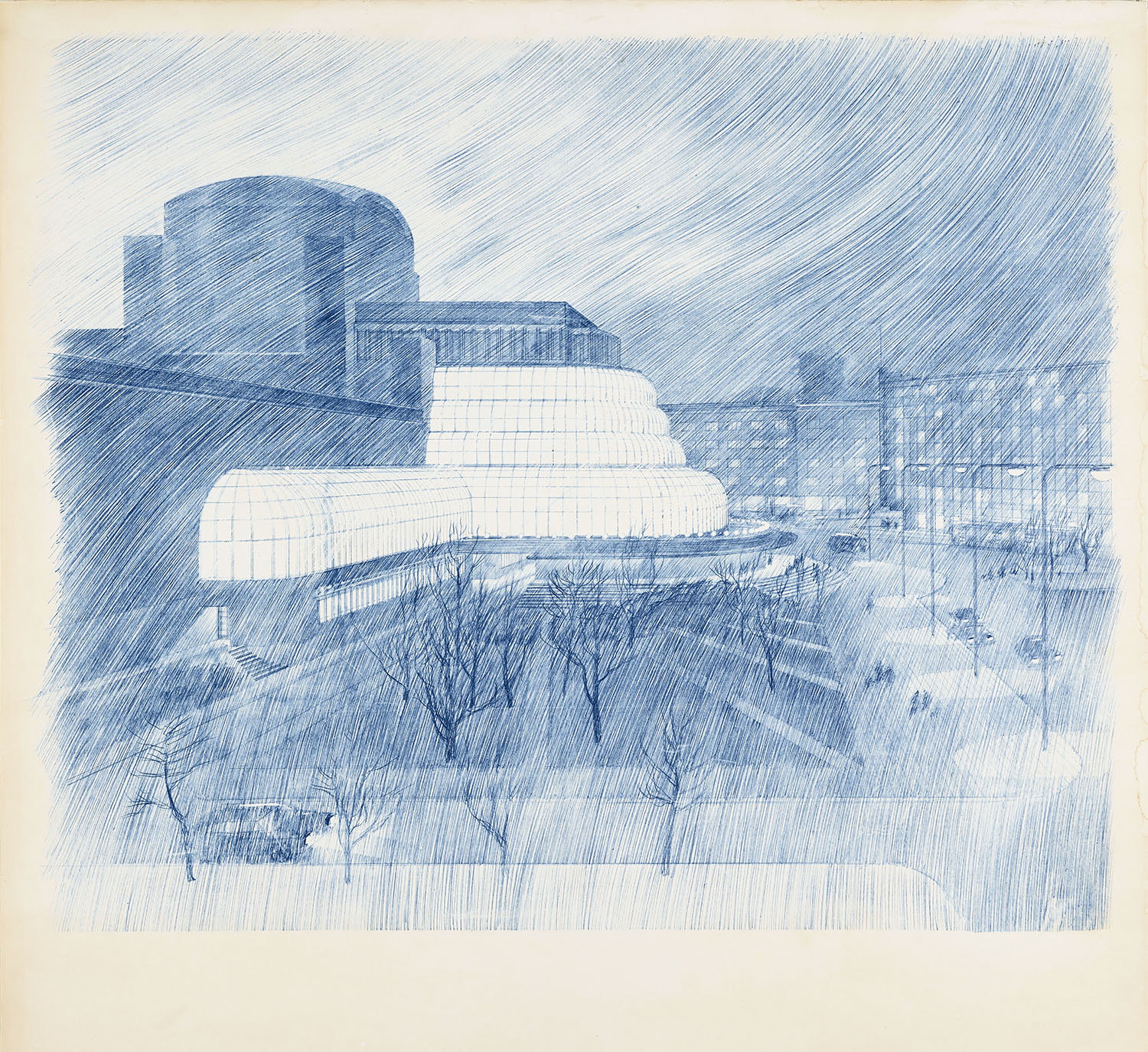
Peep Jänes, Henno Sepmann, Rein Kersten, Loona Kikkas, 1986. EAM 5.4.35
Tallinn’s new opera and ballet theatre was planned to be built in the area of Süda Street, in the intersection of Pärnu Road, Süda Street and the planned extension of Rävala Boulevard. Architects Peep Jänes and Henno Sepmann won the invited architectural competition in 1984. A year later, together with architects Rein Kersten and Loona Kikkas, they began designing an opera theatre that meets modern requirements. The project of the new opera house was grandiose. The most spectacular part of the building, the brightest in the evening, was to be the curved glass facade. A powerfully shaped stage tower was to crown the central part of the building To balance the scale of the building, the choice of materials and colours was modest: grey reflective glass, silver grey glazed brick and dolomite, to make the building look harmonious with the historical buildings and Tallinn Town Wall. The theatre building’s large hall with four balconies had to accommodate 1,100 spectators. The choice of the location of the monumental building caused an active discussion in the society; there were both passionate supporters and ardent opponents. The new opera and ballet theatre would have significantly changed the milieu of the Süda Street area, the existing buildings would have been demolished and a number of trees, including the protected ginkgo tree, would have been cut down. To preserve the ginkgo, a square was planned in front of the opera house. The design process for the new opera house, which lasted several years, ended in November 1988 and the building was never constructed. Text: Anna-Liiza Izbaš
Veel: 1980ndad, 1980s, architect: Henno Sepmann, architect: Loona Kikkas, architect: Peep Jänes, architect: Rein Kersten
The Architects’ House
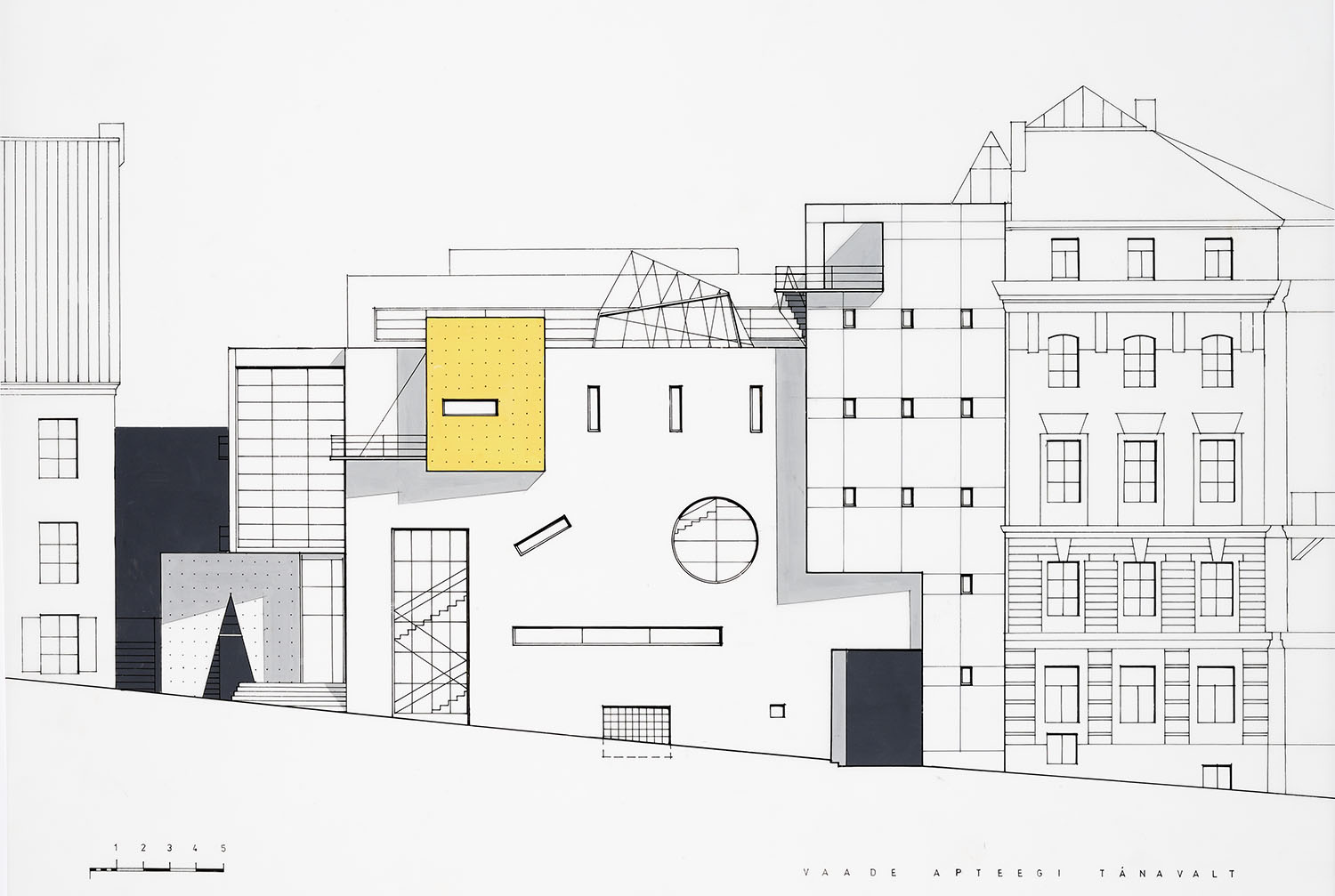
Andres Siim, 1989. EAM 5.4.9
The Architects’ House was to become the centre of Estonian architectural life, replacing the buildings destroyed during the war on the Apteegi Street in Tallinn’s old town. Among the 11 entries in the architectural competition, which ended in the spring of 1989, the design “Eclipse” by architect Andres Siim stood out. His work corresponded to the vision of the architects’ house and was awarded the first prize in the competition. The building had to be based on the structure of historically developed properties in the old town; the new building had to represent contemporary architecture in a dignified manner, while the volume of the building, the articulation of the facade and the roofscape had to match the milieu of the old town. The jury highlighted the conformity of the external and internal spatial solution, the multi-layered and interesting floorplan of the Architects’ House designed by Andres Siim. The narrow plots, characteristic of the old town, were clearly reflected in the facade design of the building, the special-shaped windows and the yellow section of the building added character. In addition to work and meeting rooms, a hall and library, cinema projection, archive and exhibition rooms and a cafe-club room were planned for the Architects’ House. Although the design of the building received positive feedback, the future progress of the project was difficult. The dream of an architects’ own house faded behind the bureaucracy of the authorities, construction and financial issues. A noteworthy project was not built. Text: Anna-Liiza Izbaš
(klick on the picture to see more illustrations)
Veel: 1980ndad, 1980s, architect: Andres Siim
Dialogue “Client-architect”
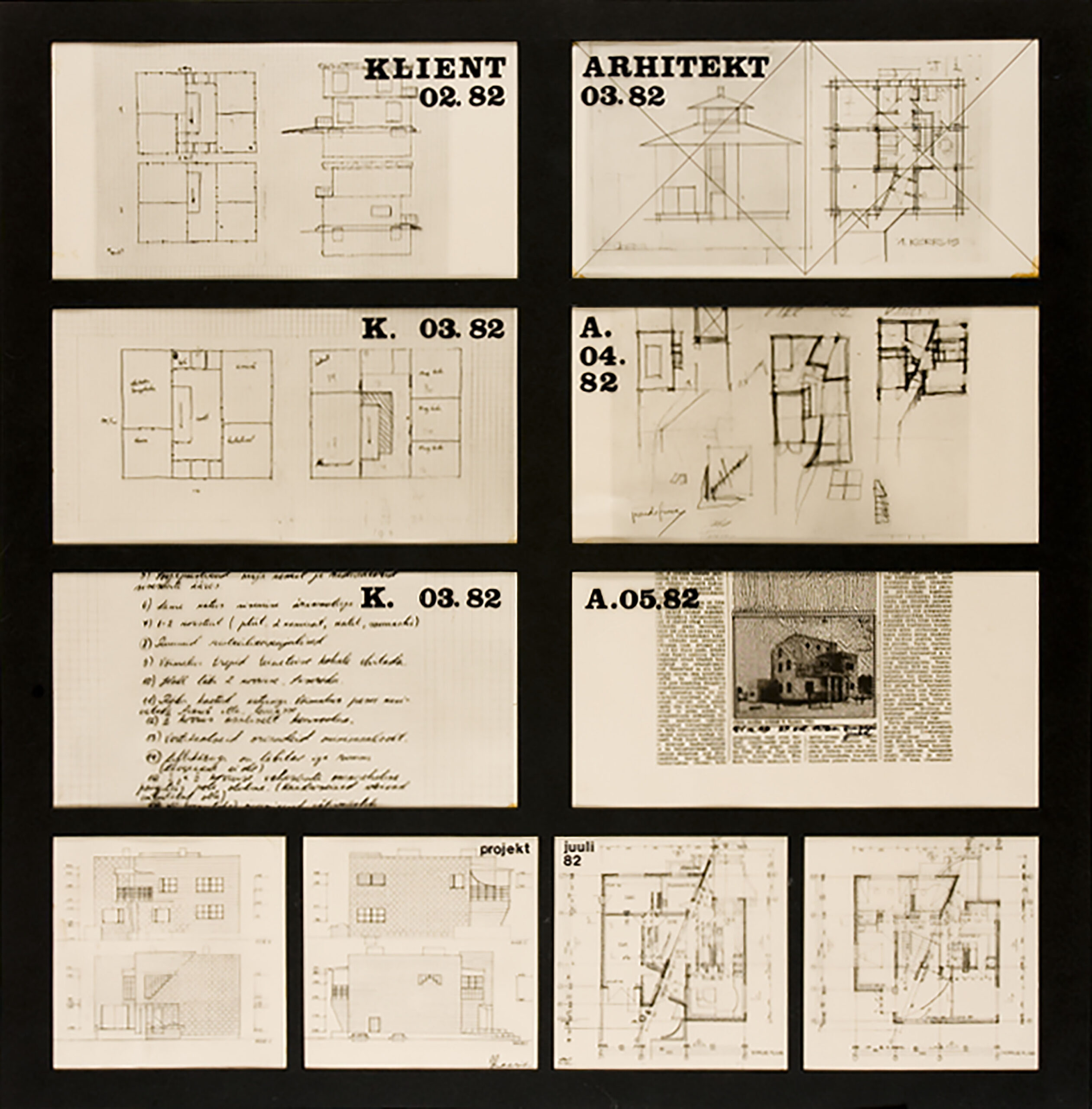
Veljo Kaasik, 1982. EAM K 31
“Client-architect” by Veljo Kaasik is a visual dialogue between the architect and the client. The work depicting the design process of a private house located on Nisu Street in Tartu shows how the building is completed in cooperation between an ambitious architect and a demanding client. Both parties are connected to each other from the planning of the building until its completion. The architect’s imaginative ideas are often influenced by the different sense of aesthetic and disagreements of the parties involved. Mostly, compromises are made. The final result is more or less different than originally planned. Veljo Kaasik’s work was on display at the exhibition of ten architects in the salon of the Tallinn Art Hall Gallery (exhibition 23.12.1982–9.01.1983). Text: Anna-Liiza Izbaš
Veel: 1980ndad, 1980s, architect: Veljo Kaasik
Sauna in Kobela
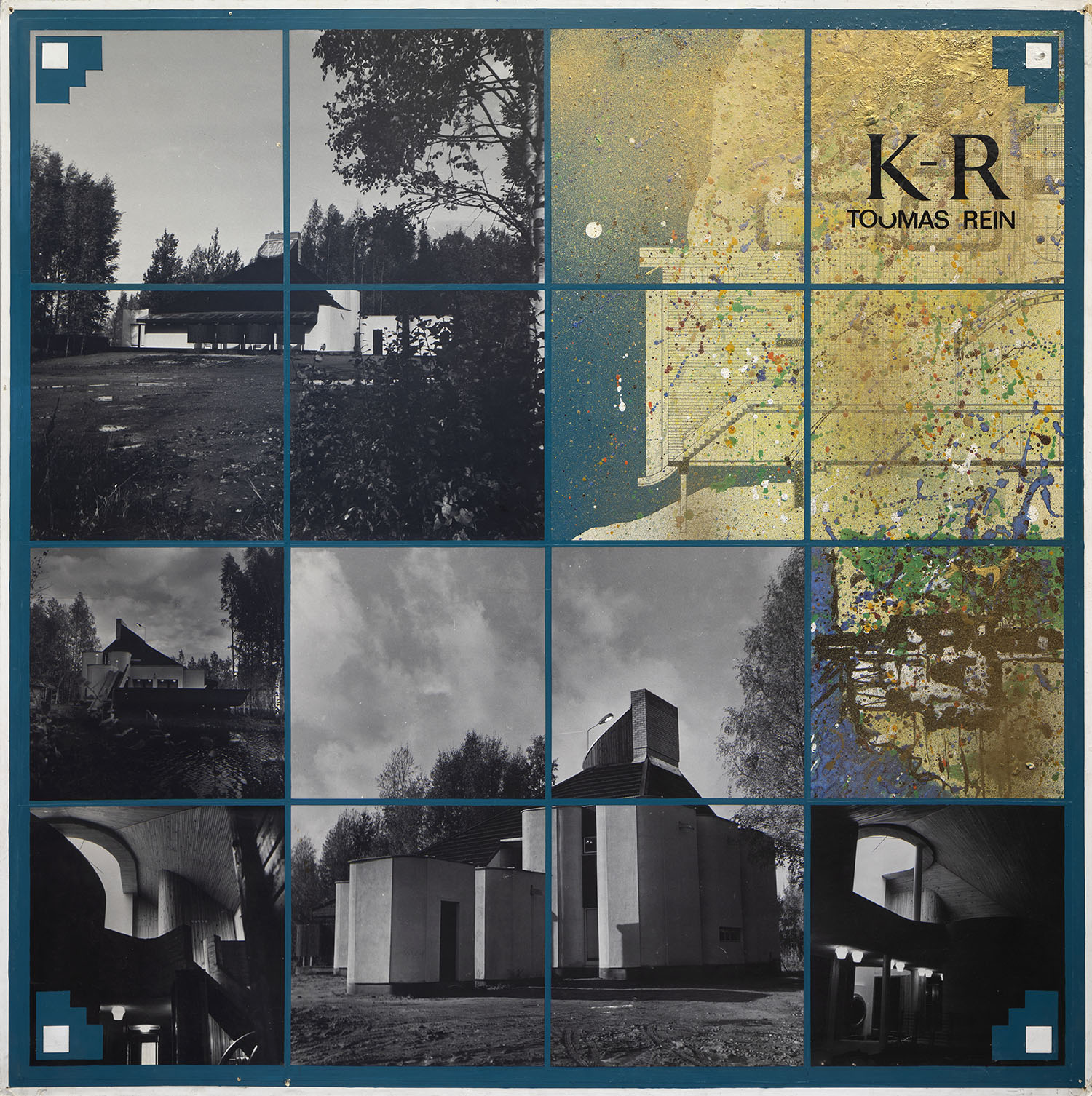
Toomas Rein, 1983. EAM 48.2.8
The Linda kolkhoz sauna, designed by architect Toomas Rein, is located in the small village of Kobela in Võru County and is one of the great examples of Estonian rural architecture. Articulated volumes, rounded corners and a red high pitched roof give character to the two-storey building, red wooden details on the windows and doors add contrast to the white facade. The sculptural exterior of the building is also reflected in the interior designed by interior architect Aulo Padar. On the first floor there was a common room with a fireplace, utility rooms and an indoor pool, on the second floor there was a sauna and laundry rooms. An indoor slide between the two floors led from the hot sauna to the cooling indoor pool. From the second floor there is also an access to the terrace of the building, from there a slide and stairs lead to the pond next to the sauna. During the renovation in the early 1990s, the function of some rooms changed and a club started to operate in the building – the indoor pool was covered with a floor and the indoor slide was demolished, the light shaft on the second floor and the glass roof were closed. The composition merges architecture, geometry and abstract painting – black and white architectural photos are arranged in a regular grid, the cross-section of the building and the ground plan are covered by a layer of gold paint and colour spots. Text: Anna-Liiza Izbaš
Veel: 1980s, architect: Toomas Rein
Graphic series “Estonian Art of Architecture”
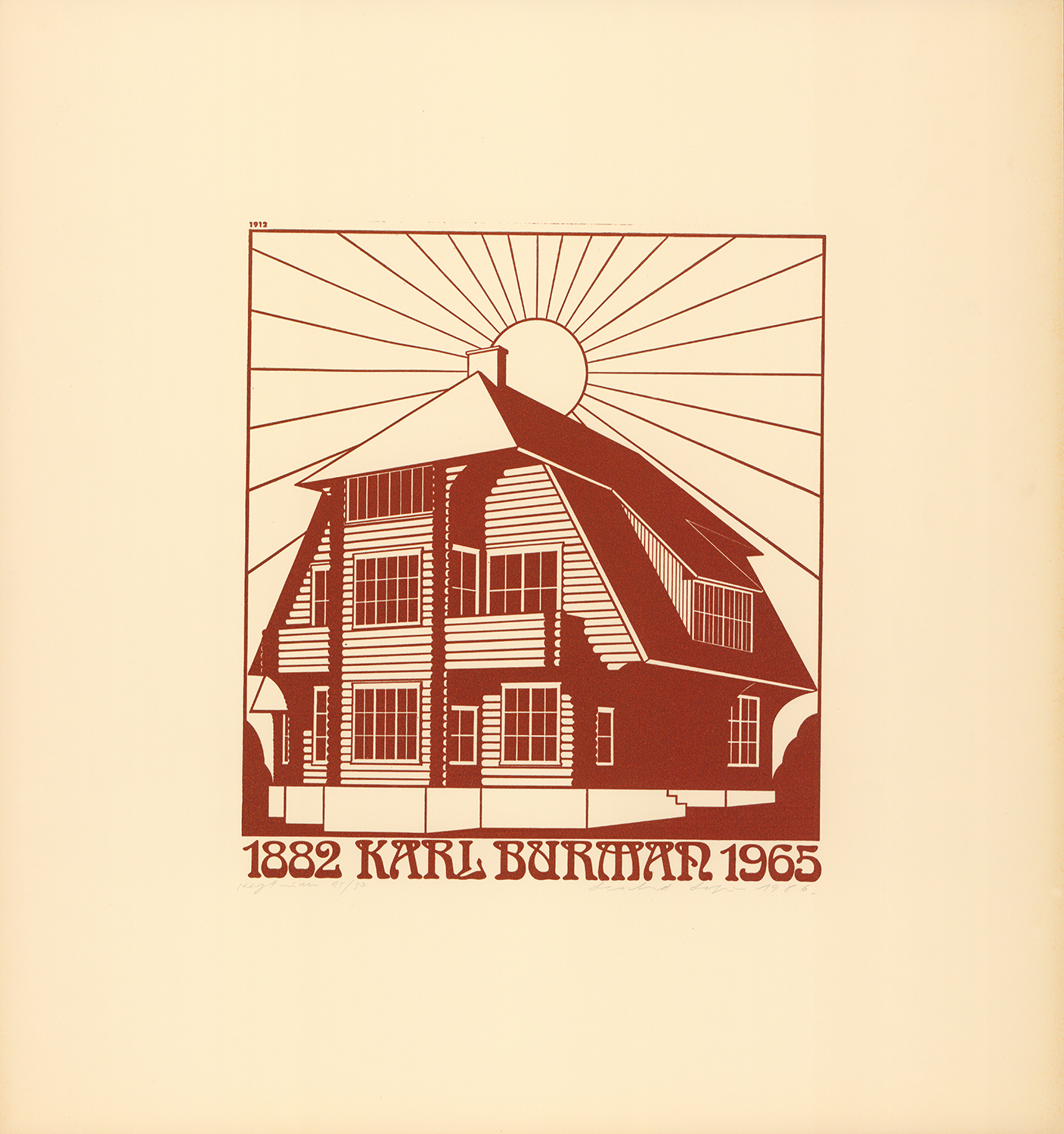
Leonhard Lapin, 1986–1988. EAM fond 68
On December 29, Leonhard Lapin would have celebrated his 75th birthday. Lapin’s legacy is characterized by bold modernist architecture, but his work was far from limited to that. Leonhard Lapin has published poetry collections and was an outstanding art innovator. Recognizable are his pop-art-influenced graphics, distinctive architecture in urban spaces and art galleries. Leonhard Lapin has kindly brought his projects and works of art to the architecture museum over the years. This year, the architectural drawings in the home archive arrived here with his legacy. As a heartfelt addition, Leonhard Lapin’s son and daughter gave the museum 5 colorful letterpress graphics from the 1980s. The series is called “Estonian Art of Architecture” and depicts the work of various masters from the early decades of the 20th century: Nikolai von Glehn’s Palm House, Georg Hellat’s Art Nouveau old Endla theater-society house, National Romantic Kalevi Yacht Club Pirital (Karl Burman), Herbert Johanson and Eugen Habermann’s Riigikogu building and Tallinn 21. School designed by Artur Perna. Text: Sandra Mälk
Veel: 1980s, architect: Leonhard Lapin
Competition entry for the shopping centre at Mere Boulevard in Tallinn
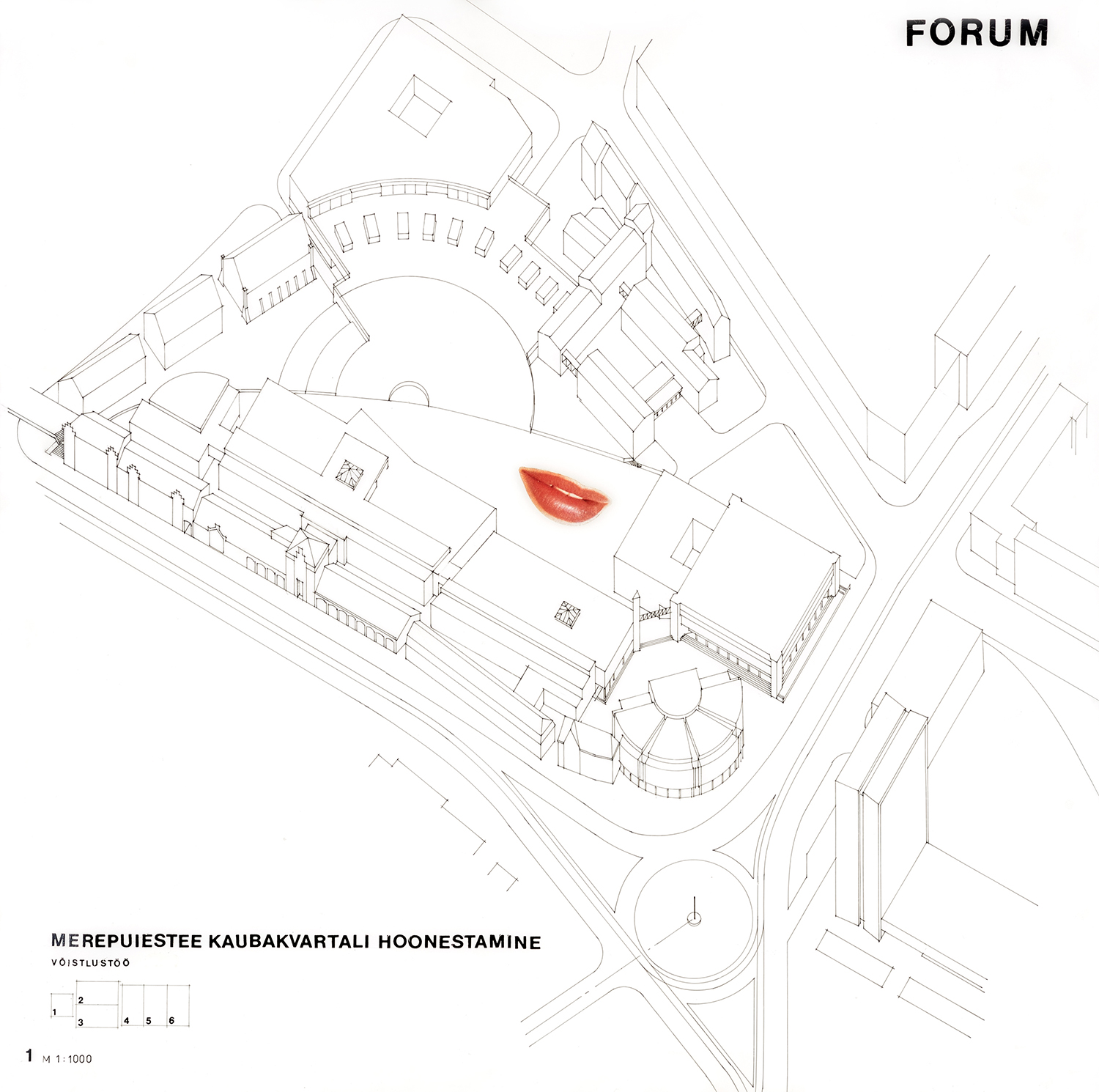
Tiina Tallinn, Ell Väärtnõu, Arvi Aasmaa, engineer Rein Karilaid, 1989. EAM 5.1.21
Up until now the factory premises of the Rotermann Quarter had been closed off and an architectural competition was organised to find a way to better incorporate the area into the urban landscape. The quarter was to be the main commercial and service centre of Tallinn. The centre of the competition entry titled “Foorum” is a crescent market square – a modern interpretation of the historic forum in ancient Rome, together with all the surrounding market pavilions. The idea of market as a place of communication is further emphasised by a collage detail of lips as a means of communication. The competition entries were given to the museum in 1993 by the Tallinn City Office. Text: Sandra Mälk
Veel: 1980s, architect: Arvi Aasmaa, architect: Ell Väärtnõu, architekt: Tiina Tallinn, engineer: Rein Karilaid
Vanalinnastuudio theatre building in Tallinn
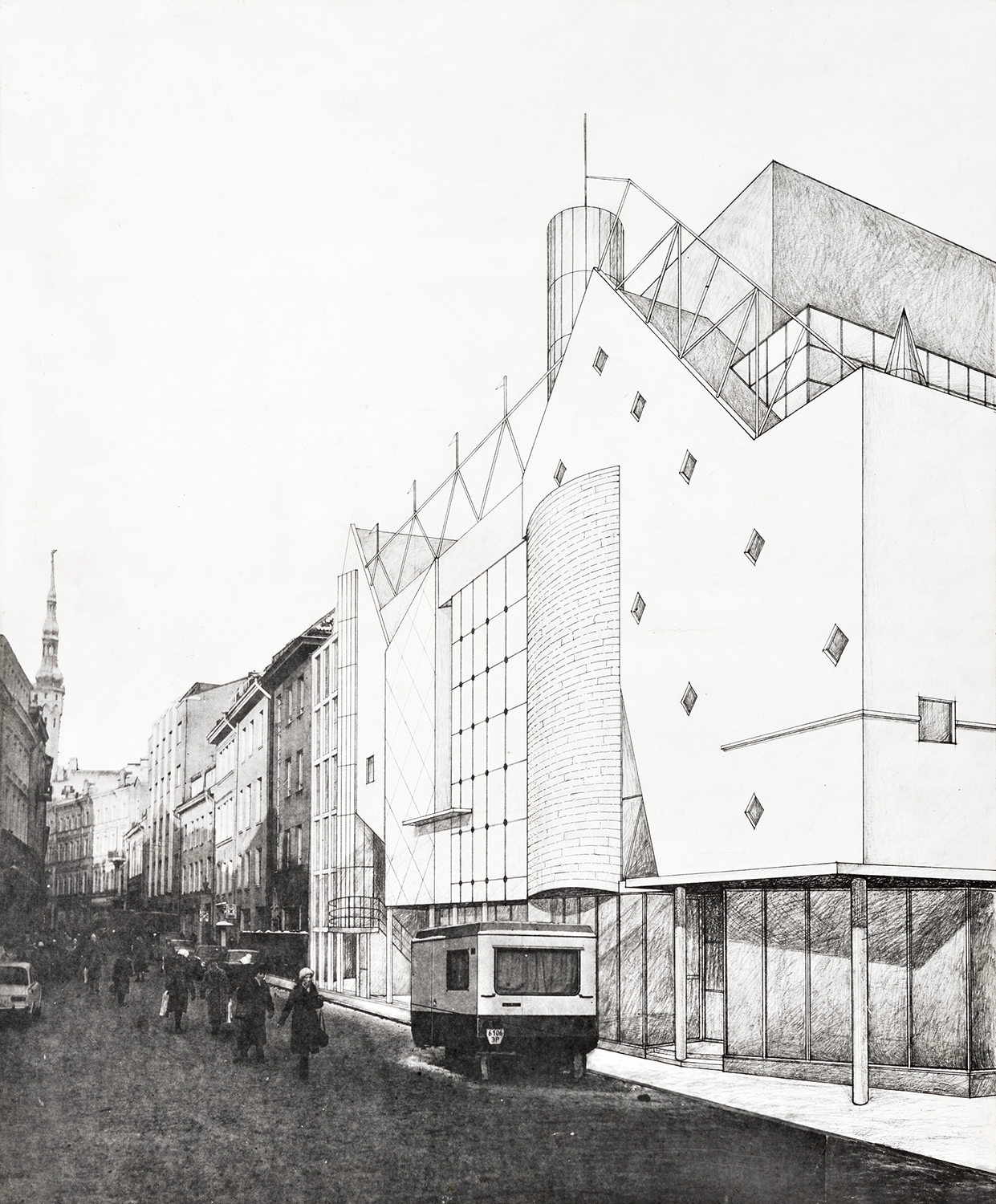
Vilen Künnapu, Ain Padrik, 1987. EAM 41.1.16
Comedy theatre Vanalinnastuudio, which started out in Tallinn Teachers’ House, became so popular under the leadership of the legendary theatre director Eino Baskin that in the mid-1980s there was an idea of building the theatre its own house in the Old Town. The beginning of Viru Street had a plot that had long been vacant (currently the De la Gardie shopping centre, 1999) and it was considered as one possible location for the building. The theatre house was designed as a black box theatre with seats for 200 people and an attic storey for lowering decorations to the stage below. The postmodernist building was never constructed under the new political regime. The display board together with the section and view was given to the museum in 2005 by architectural historian Liivi Künnapu. In addition to that, last year the architecture office Künnapu&Padrik donated their drawings and digital archive to the museum. The lot, consisting almost 200 projects, is in the final process of adding to the musem’s collection. Text: Sandra Mälk
Veel: 1980s, architect: Ain Padrik, architect: Vilen Künnapu, Tallinn
Festive document for the re-establishment of the Estonian Association of Architects
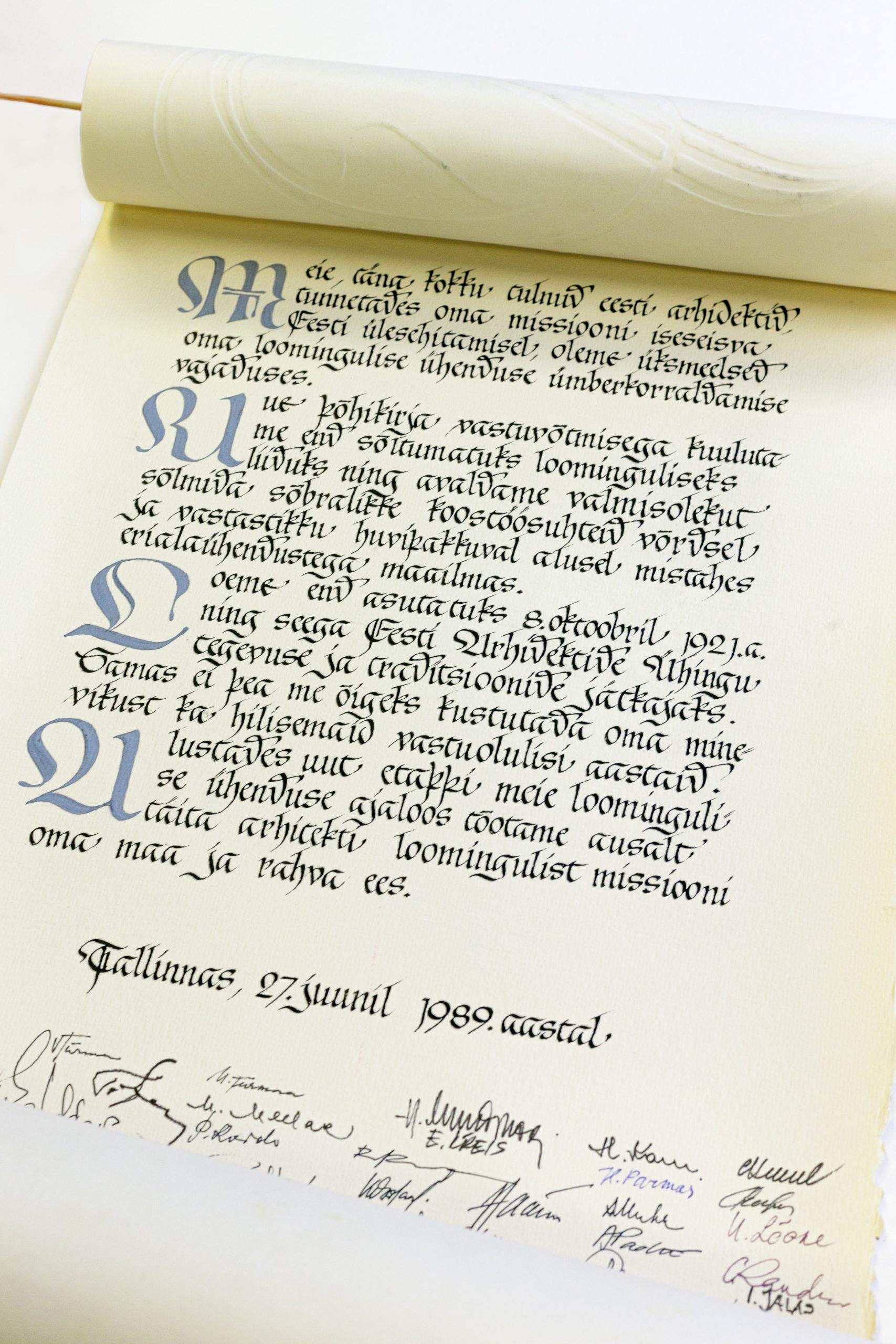
Document of the EEA,1989. EAM 10.4.9
The Estonian Association of Architects was the first of the creative associations to strive for independence in the late 1980s and to break away from the all-union USSR Union of Architects. The first groundbreaking decision was taken one day in November 1987, when a meeting was held to discuss the association’s activities. The architects decided that from now on the beginning date of the creative union should no longer be known as 1944, but the day of the establishment of the Estonian Union of Architects on October 8, 1921. The following year, by the initiative of architect Leonhard Lapin, the union decided to continue as an independent association. For this, a ceremonial document was drawn up in 27 June 1989. This beautiful document with a calligraphic text and the signatures of the architects made it possible to summon the official charter that was registered in November 1989. By this general assembly of the EEA selected the first board and architect Ike Volkov as the first chairman of the association. The master of the leatherwork that holds the paper document together is Aime Pralla. The EEA gave the document to the museum for the safekeeping in 1998. Text: Sandra Mälk (click on the image to see more photos)
Veel: 1980s
EMA 30 / Tiny tour of models: Extension to Tallinn Secondary School of Science
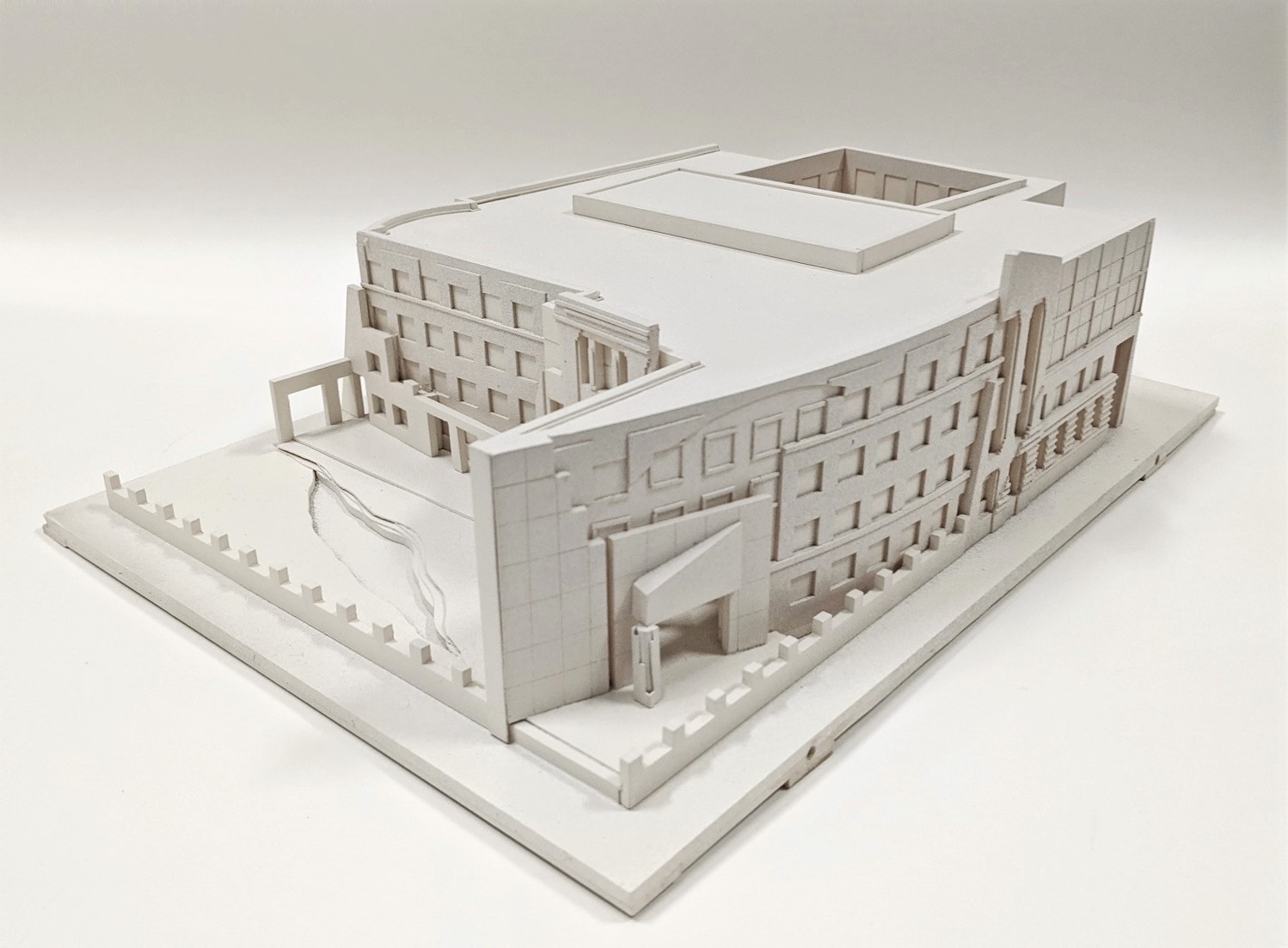
Marika Lõoke, 1981. MK 227
Tallinn Secondary School of Science (Tallinna Reaalkool) will be 140 years old this year. The school was founded in 1881, in the same year an all-Russian architectural competition was organized to obtain a schoolhouse project. The competition was won by Max Hoeppener (1848–1924), a Baltic German architect from Moscow. Hoeppener was assisted in the construction project by Carl Gustav Jacoby, a Tallinn city engineer at the time. The first building designed for a school building in Tallinn was completed in 1884.
A century later, in 1981, a competition was held for a vision of the extension of the school building. The location of the new addition was to be set on the current sports field. 13 works came to the competition. The first prize was given to the architects Vilen Künnapu and Ain Padrik for the project named “Kivirünta” (EAM 41.1.10), the second place went to Kullervo Kliimand’s work “Poiss” (“A Boy”). The third prize was shared by Kiira Soosaar, Siiri Kasemets and Jüri Karu’s competition work “Imelik” (“Strange”) and “Koolimaja” (“School House) by Marika Lõoke. In the magazine Ehituskunst, the editor of the magazine, architect Ado Eigi, describes it as follows: “ In addition to the attractively playful, postmodernist façades maintained at a good professional level and the expressive plan solution, the competition work “Koolimaja” (author Marika Lõoke) also suggested an interesting corner solution together with the M. Gorky named Library building (now Tallinn Central Library – A.L.).” A year later Marika Lõoke also received the 3rd prize at the competition for the new building of the Kreutzwald State Library. The library competition model belonging to the collection of the Museum of Architecture can be seen in the soon-to-open exhibition at the National Library. Together with several other models, the author donated them to the museum in 2017. See also “Architecture. Second-third, 1982–1983.” Text: Anne Lass
Veel: 1980s, architect: Marika Lõoke, Tallinn
Linnahall Square and the Merepargi Taimelinn (the Plant City of the Sea Park)
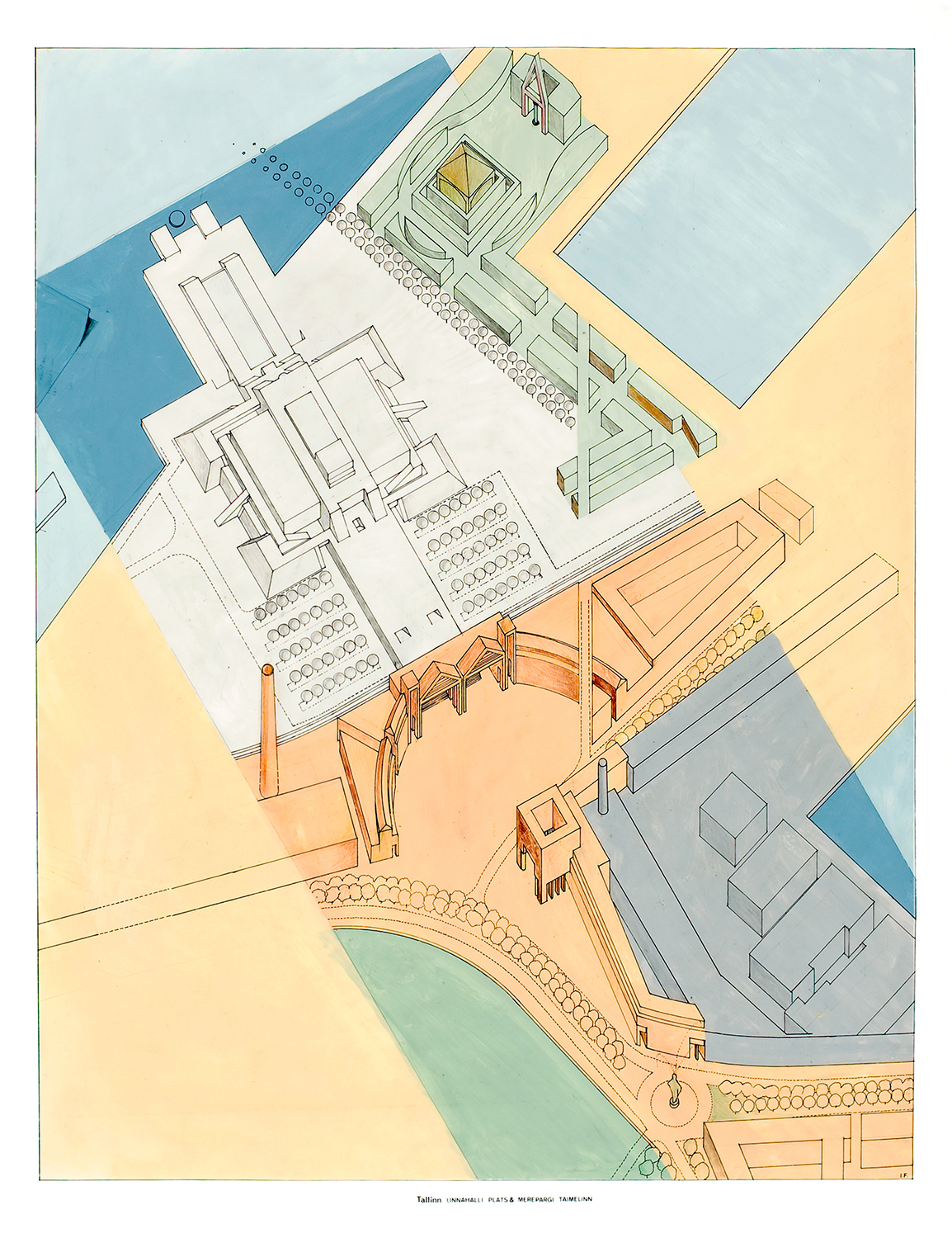
Ignar Fjuk, 1982. EAM 5.4.61
Tallinn Linnahall was built during the building frenzy which preceded the 1980 Olympics, but the surroundings were not developed as planned. The area between the power station and the commercial port was cleaned of the production residue from the factories and the concrete blocks that were laying around. At the same time, discussions became louder about granting people in the city access to the coastal zone, which had thus far belonged to the border zone and been managed by large factories. Ignar Fjuk designed a green park area to surround the Linnahall, which also included a place for architectural forms – gates and pavilions. He presented his vision in the group exhibition ofthe Tallinn School, which took place at the Tallinn Art Salon in 1983. This illustration made in ink and gouache was given to the museum as a gift by the author in 2002. Text: Sandra Mälk
Veel: 1980s, architect: Ignar Fjuk, Tallinn












